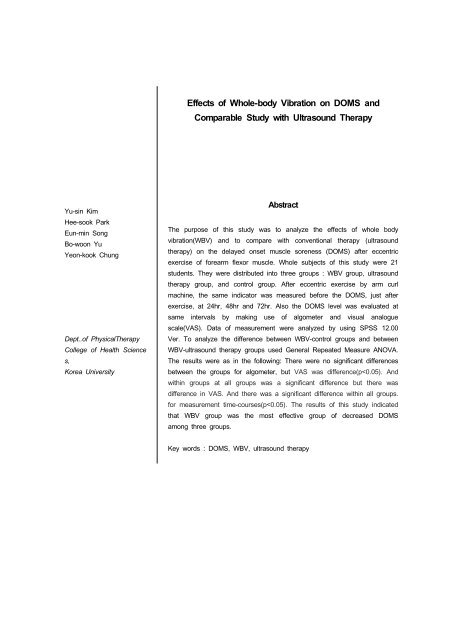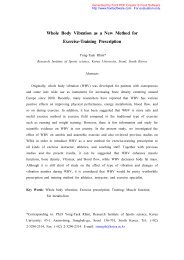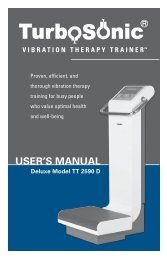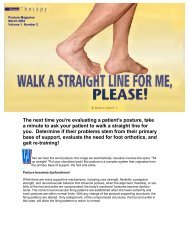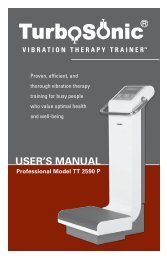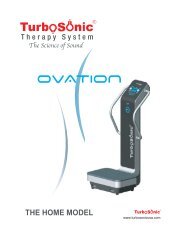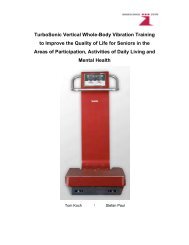Effects of Whole-body Vibration on DOMS and ... - Sonic Life
Effects of Whole-body Vibration on DOMS and ... - Sonic Life
Effects of Whole-body Vibration on DOMS and ... - Sonic Life
You also want an ePaper? Increase the reach of your titles
YUMPU automatically turns print PDFs into web optimized ePapers that Google loves.
<str<strong>on</strong>g>Effects</str<strong>on</strong>g> <str<strong>on</strong>g>of</str<strong>on</strong>g> <str<strong>on</strong>g>Whole</str<strong>on</strong>g>-<str<strong>on</strong>g>body</str<strong>on</strong>g> <str<strong>on</strong>g>Vibrati<strong>on</strong></str<strong>on</strong>g> <strong>on</strong> <strong>DOMS</strong> <strong>and</strong><br />
Comparable Study with Ultrasound Therapy<br />
Yu-sin Kim<br />
Hee-sook Park<br />
Eun-min S<strong>on</strong>g<br />
Bo-wo<strong>on</strong> Yu<br />
Ye<strong>on</strong>-kook Chung<br />
Dept..<str<strong>on</strong>g>of</str<strong>on</strong>g> PhysicalTherapy<br />
College <str<strong>on</strong>g>of</str<strong>on</strong>g> Health Science<br />
s,<br />
Korea University<br />
Abstract<br />
The purpose <str<strong>on</strong>g>of</str<strong>on</strong>g> this study was to analyze the effects <str<strong>on</strong>g>of</str<strong>on</strong>g> whole <str<strong>on</strong>g>body</str<strong>on</strong>g><br />
vibrati<strong>on</strong>(WBV) <strong>and</strong> to compare with c<strong>on</strong>venti<strong>on</strong>al therapy (ultrasound<br />
therapy) <strong>on</strong> the delayed <strong>on</strong>set muscle soreness (<strong>DOMS</strong>) after eccentric<br />
exercise <str<strong>on</strong>g>of</str<strong>on</strong>g> forearm flexor muscle. <str<strong>on</strong>g>Whole</str<strong>on</strong>g> subjects <str<strong>on</strong>g>of</str<strong>on</strong>g> this study were 21<br />
students. They were distributed into three groups : WBV group, ultrasound<br />
therapy group, <strong>and</strong> c<strong>on</strong>trol group. After eccentric exercise by arm curl<br />
machine, the same indicator was measured before the <strong>DOMS</strong>, just after<br />
exercise, at 24hr, 48hr <strong>and</strong> 72hr. Also the <strong>DOMS</strong> level was evaluated at<br />
same intervals by making use <str<strong>on</strong>g>of</str<strong>on</strong>g> algometer <strong>and</strong> visual analogue<br />
scale(VAS). Data <str<strong>on</strong>g>of</str<strong>on</strong>g> measurement were analyzed by using SPSS 12.00<br />
Ver. To analyze the difference between WBV-c<strong>on</strong>trol groups <strong>and</strong> between<br />
WBV-ultrasound therapy groups used General Repeated Measure ANOVA.<br />
The results were as in the following: There were no significant differences<br />
between the groups for algometer, but VAS was difference(p
. Introducti<strong>on</strong><br />
The studies <strong>on</strong> vibrati<strong>on</strong> have been currently<br />
d<strong>on</strong>e by researchers in the world <strong>and</strong> their<br />
subsequent varied experiment results have been<br />
published. These studies focused <strong>on</strong> the physical<br />
change in the workers who used the vibrating<br />
tools in industrial spots. In 1991, Bovenzi reported<br />
that those who were exposed to a l<strong>on</strong>g-term<br />
vocati<strong>on</strong>al vibrati<strong>on</strong> had a weak grip. In additi<strong>on</strong>,<br />
it has been reported that the laborers who<br />
worked with vibrating tools such as an electric<br />
saw experienced paleness in fingers due to the<br />
c<strong>on</strong>tracti<strong>on</strong> <str<strong>on</strong>g>of</str<strong>on</strong>g> finger blood vessel (Bovenzi &<br />
Griffin, 1997). In the similar token, there have<br />
been reports that the amount <str<strong>on</strong>g>of</str<strong>on</strong>g> blood flow <str<strong>on</strong>g>of</str<strong>on</strong>g><br />
industrial workers who worked with industrial<br />
devices with 80 100 <str<strong>on</strong>g>of</str<strong>on</strong>g> the number <str<strong>on</strong>g>of</str<strong>on</strong>g><br />
vibrati<strong>on</strong>s has been significantly reduced<br />
(Lundsrom & Burstom, 1988). As such, most <str<strong>on</strong>g>of</str<strong>on</strong>g><br />
the researches claimed that the l<strong>on</strong>g-term use <str<strong>on</strong>g>of</str<strong>on</strong>g><br />
vibrating tools in the industrial spots would cause<br />
a negative effect <strong>on</strong> physical activities.<br />
However, there have been many<br />
researches <strong>on</strong> the 'differences <str<strong>on</strong>g>of</str<strong>on</strong>g> physical<br />
reacti<strong>on</strong>s <strong>and</strong> effects' between vibrati<strong>on</strong>s in<br />
industrial spots applied in high-frequency, large<br />
amplitude <strong>and</strong> physical <str<strong>on</strong>g>body</str<strong>on</strong>g> for a l<strong>on</strong>g period <str<strong>on</strong>g>of</str<strong>on</strong>g><br />
time <strong>and</strong> vibrati<strong>on</strong>s applied in low-frequency, small<br />
amplitude <strong>and</strong> physical <str<strong>on</strong>g>body</str<strong>on</strong>g> for a short period<br />
time in the 1990s; in this process, the usefulness<br />
<str<strong>on</strong>g>of</str<strong>on</strong>g> whole <str<strong>on</strong>g>body</str<strong>on</strong>g> vibrati<strong>on</strong> has been evaluated as a<br />
new exercise method. In particular, as the studies<br />
<strong>on</strong> sports <strong>and</strong> rehabilitati<strong>on</strong> fields have been<br />
c<strong>on</strong>ducted actively, some data that evaluated the<br />
effects <str<strong>on</strong>g>of</str<strong>on</strong>g> whole <str<strong>on</strong>g>body</str<strong>on</strong>g> vibrati<strong>on</strong> have been<br />
released (Rittweger et al, 2002). These data had<br />
something to do largely with the effects <strong>on</strong><br />
muscular power, nervous system, blood<br />
circulati<strong>on</strong>, change in metabolism <strong>and</strong> b<strong>on</strong>e<br />
density.<br />
Kannus et al(2002) c<strong>on</strong>ducted whole<br />
<str<strong>on</strong>g>body</str<strong>on</strong>g> vibrati<strong>on</strong> at the frequency <str<strong>on</strong>g>of</str<strong>on</strong>g> 3-5 times a<br />
week for 4 m<strong>on</strong>ths for 56 male <strong>and</strong> female<br />
healthy participants <strong>and</strong> the vertical jumping<br />
power increased by 10.2% in 2 m<strong>on</strong>ths <strong>and</strong> by<br />
8.5% in 4 m<strong>on</strong>ths in the experimental group;<br />
meanwhile, flexi<strong>on</strong> muscle strength <str<strong>on</strong>g>of</str<strong>on</strong>g> leg muscles<br />
increased by 3.7% in 2 m<strong>on</strong>ths <strong>and</strong> by 2.5% in 4<br />
m<strong>on</strong>ths. According to Torvinen et al (2002), the<br />
applicati<strong>on</strong> <str<strong>on</strong>g>of</str<strong>on</strong>g> a 4-minute short-term whole <str<strong>on</strong>g>body</str<strong>on</strong>g><br />
vibrati<strong>on</strong> enhanced the isometric muscular strength<br />
<str<strong>on</strong>g>of</str<strong>on</strong>g> knee extensor by 3.2% <strong>and</strong> the bodily balance<br />
by 15.7%. Delecruise(2003) applied the existing<br />
resistance exercise <strong>and</strong> whole <str<strong>on</strong>g>body</str<strong>on</strong>g> vibrati<strong>on</strong> for<br />
12 weeks into female participants who were not<br />
trained; as a result, two exercises showed the<br />
muscular increase in knee extensor for the same<br />
knee joints <strong>and</strong> <strong>on</strong>ly whole <str<strong>on</strong>g>body</str<strong>on</strong>g> vibrati<strong>on</strong><br />
increased significantly in the counter movement<br />
jump. In additi<strong>on</strong>, there have been reports that<br />
the applicati<strong>on</strong> <str<strong>on</strong>g>of</str<strong>on</strong>g> a single vibrati<strong>on</strong> (26 , 10<br />
minutes) increased the muscles <str<strong>on</strong>g>of</str<strong>on</strong>g> female volley<br />
ball athletes temporarily (Bosco et al, 1999).<br />
Besides, in another experiment, Bosco et al(1999)<br />
announced that the highest jumping height, agility<br />
at time <str<strong>on</strong>g>of</str<strong>on</strong>g> highest jump <strong>and</strong> c<strong>on</strong>secutive jump for<br />
five minutes in the experimental group increased<br />
noticeably in the mean <str<strong>on</strong>g>of</str<strong>on</strong>g> height <strong>and</strong> they were<br />
statistically significant. When applying three<br />
exercises such as st<strong>and</strong>ing <strong>on</strong> the vibrati<strong>on</strong> board<br />
that had whole <str<strong>on</strong>g>body</str<strong>on</strong>g> vibrati<strong>on</strong>, squat <strong>and</strong> squat<br />
loaded with weight, it would increase oxygen<br />
uptake (VO 2) <strong>and</strong> metabolism by adding vibrati<strong>on</strong><br />
<strong>on</strong> whole <str<strong>on</strong>g>body</str<strong>on</strong>g> more than by not adding vibrati<strong>on</strong><br />
<strong>on</strong> whole <str<strong>on</strong>g>body</str<strong>on</strong>g>, according to the research<br />
(Rittweger et al, 2001). Furthermore, Schin (2001)<br />
announced that the speed <str<strong>on</strong>g>of</str<strong>on</strong>g> blood flow <str<strong>on</strong>g>of</str<strong>on</strong>g><br />
peripheral blood vessel increased <strong>and</strong> the<br />
resistance to blood flow decreased when adding<br />
whole <str<strong>on</strong>g>body</str<strong>on</strong>g> vibrati<strong>on</strong> <str<strong>on</strong>g>of</str<strong>on</strong>g> 26Hz <str<strong>on</strong>g>of</str<strong>on</strong>g> frequency <strong>and</strong><br />
3mm <str<strong>on</strong>g>of</str<strong>on</strong>g> amplitude <str<strong>on</strong>g>of</str<strong>on</strong>g> vibrati<strong>on</strong>. As such research<br />
results that whole <str<strong>on</strong>g>body</str<strong>on</strong>g> vibrati<strong>on</strong> had positive<br />
effects <strong>on</strong> physical abilities were published, it has<br />
been suggested as a new exercise method to the
athletes <str<strong>on</strong>g>of</str<strong>on</strong>g> various sports teams.<br />
In additi<strong>on</strong>, it has been found that a<br />
3-m<strong>on</strong>th whole <str<strong>on</strong>g>body</str<strong>on</strong>g> vibrati<strong>on</strong> affected the<br />
increase in lumbar strength in the treatment <str<strong>on</strong>g>of</str<strong>on</strong>g><br />
chr<strong>on</strong>ic lumbago (Rittweger et al, 2002).<br />
Furthermore, there was also a research claiming<br />
that whole <str<strong>on</strong>g>body</str<strong>on</strong>g> vibrati<strong>on</strong> had the functi<strong>on</strong>s <str<strong>on</strong>g>of</str<strong>on</strong>g><br />
strengthening neuromuscular activities <strong>and</strong><br />
muscular strength (Bosco et al, 1999). In another<br />
research, it has been shown that a sense <str<strong>on</strong>g>of</str<strong>on</strong>g><br />
unique acceptance <str<strong>on</strong>g>of</str<strong>on</strong>g> lumbosacral part was<br />
improved as a result <str<strong>on</strong>g>of</str<strong>on</strong>g> performing a 5-minute<br />
statically closed chain moti<strong>on</strong> (18Hz) <strong>on</strong> the<br />
vibrati<strong>on</strong> board (F<strong>on</strong>tana et al, 2005). As such,<br />
there have been some grounds that current whole<br />
<str<strong>on</strong>g>body</str<strong>on</strong>g> vibrati<strong>on</strong> could be used in treatment as well<br />
as strengthening muscular strength or physical<br />
power. However, what was missing was that there<br />
have been researches <strong>on</strong>ly <strong>on</strong> the improvement<br />
<str<strong>on</strong>g>of</str<strong>on</strong>g> muscular strength weakening <str<strong>on</strong>g>of</str<strong>on</strong>g> whole <str<strong>on</strong>g>body</str<strong>on</strong>g><br />
vibrati<strong>on</strong> by chr<strong>on</strong>ic lumbago, lumbar diseases or<br />
l<strong>on</strong>g-term hospitalizati<strong>on</strong> for the purpose <str<strong>on</strong>g>of</str<strong>on</strong>g><br />
treatment; for this reas<strong>on</strong>, there have been less<br />
studies <strong>on</strong> the short-term injuries such as a<br />
bruise or delayed <strong>on</strong>set muscle soreness (<strong>DOMS</strong>).<br />
Therefore, this study attempted to<br />
compare whole <str<strong>on</strong>g>body</str<strong>on</strong>g> vibrati<strong>on</strong> with a ultrasound<br />
therapy (Hass<strong>on</strong> et al, 1990) (that has been<br />
published as an effective treatment for the<br />
<strong>DOMS</strong>) in order to look closely into the effects <str<strong>on</strong>g>of</str<strong>on</strong>g><br />
whole <str<strong>on</strong>g>body</str<strong>on</strong>g> vibrati<strong>on</strong> <strong>on</strong> the <strong>DOMS</strong> that had<br />
short-term c<strong>on</strong>tinuance <str<strong>on</strong>g>of</str<strong>on</strong>g> symptoms.<br />
. Research methods<br />
1. Subject <str<strong>on</strong>g>of</str<strong>on</strong>g> study<br />
The subjects <str<strong>on</strong>g>of</str<strong>on</strong>g> study included 21<br />
students from K University. The subjects did not<br />
have any diseases or take any medicine that<br />
could affect this experiment, <strong>and</strong> they have not<br />
d<strong>on</strong>e a muscular exercise for the last 6 m<strong>on</strong>ths.<br />
The subjects <str<strong>on</strong>g>of</str<strong>on</strong>g> study were allocated r<strong>and</strong>omly to<br />
whole <str<strong>on</strong>g>body</str<strong>on</strong>g> vibrati<strong>on</strong> group, ultrasound therapy<br />
group <strong>and</strong> c<strong>on</strong>trol group. During the experiment,<br />
they were forced not to do exercises <strong>and</strong> drink<br />
alcohol that could affect the results <str<strong>on</strong>g>of</str<strong>on</strong>g> study <strong>and</strong><br />
they were limited to the use <str<strong>on</strong>g>of</str<strong>on</strong>g> cigarettes, c<str<strong>on</strong>g>of</str<strong>on</strong>g>fee,<br />
meal, etc. that could also affect the results <str<strong>on</strong>g>of</str<strong>on</strong>g><br />
study 2 hours before the experiment.<br />
Table 1. Physical Characteristic <str<strong>on</strong>g>of</str<strong>on</strong>g> Subjects<br />
Group Age(yrs) Height(cm) Weight(kg)<br />
22.75 175.75 72.50<br />
Man<br />
±1.70 ±1.03 ±7.59<br />
Woman<br />
*p
TSKOREA Co., Ltd.) was used <strong>and</strong> its frequency<br />
was fixed at 26 <strong>and</strong> its intensity was applied<br />
from 100 to 30. Then, the center <str<strong>on</strong>g>of</str<strong>on</strong>g> vibrati<strong>on</strong><br />
board was located between two legs at the width<br />
<str<strong>on</strong>g>of</str<strong>on</strong>g> shoulder at the same interval; in the meantime,<br />
the participants experienced the vibrati<strong>on</strong> intensity<br />
<str<strong>on</strong>g>of</str<strong>on</strong>g> 70 for a minute before starting to have actual<br />
vibrati<strong>on</strong> so as to avoid the change in their<br />
physical activities with the sudden applicati<strong>on</strong> <str<strong>on</strong>g>of</str<strong>on</strong>g><br />
vibrati<strong>on</strong>s.<br />
Table 2. The exercise program <strong>on</strong> WBV<br />
time(min) 2 2 2 1 1 1 1 1<br />
volume 100 90 80 70 60 50 40 30<br />
* Frequency = 26<br />
The participants from the ultrasound<br />
therapy group were placed <strong>on</strong> the table while a<br />
rotati<strong>on</strong> transfer method was applied so as for<br />
each half <str<strong>on</strong>g>of</str<strong>on</strong>g> the c<strong>on</strong>tact surface <str<strong>on</strong>g>of</str<strong>on</strong>g> a c<strong>on</strong>verter to<br />
be overlapped. The c<strong>on</strong>verter was put at right<br />
angle to their skin <strong>and</strong> the coupling medium <str<strong>on</strong>g>of</str<strong>on</strong>g><br />
ultrasound was rubbed lightly between the<br />
c<strong>on</strong>verter <strong>and</strong> skin. The frequency <strong>and</strong> intensity<br />
were 1 <strong>and</strong> 1.2W/ , respectively, <strong>and</strong> it was<br />
applied to the biceps area for 12 minutes. For<br />
the c<strong>on</strong>trol group, no further treatment has been<br />
d<strong>on</strong>e.<br />
Figure 1. S<strong>on</strong>ic <str<strong>on</strong>g>Whole</str<strong>on</strong>g>-Body <str<strong>on</strong>g>Vibrati<strong>on</strong></str<strong>on</strong>g><br />
4. Measurement methods<br />
A pressure measuring device was used<br />
to measure the pressure threshold before <strong>DOMS</strong>'<br />
being induced <strong>and</strong> after 24, 48 <strong>and</strong> 72 hours.<br />
The measurement was made in the same point<br />
after marking it in the center <str<strong>on</strong>g>of</str<strong>on</strong>g> muscle belly <str<strong>on</strong>g>of</str<strong>on</strong>g><br />
biceps. Pressure was added perpendicularly to the<br />
measurement point by the pressure measuring<br />
device. In case that the participants screamed<br />
'Ah!' when they felt a pain, the tester measured<br />
the pressure <str<strong>on</strong>g>of</str<strong>on</strong>g> that moment by pressure<br />
threshold <strong>and</strong> its measurement unit was / .<br />
Besides, the study utilized a VAS (visual analog<br />
scale) using the scale <str<strong>on</strong>g>of</str<strong>on</strong>g> 10cm in total at 1mm<br />
interval to examine the degree <str<strong>on</strong>g>of</str<strong>on</strong>g> a pain felt<br />
subjectively after having the <strong>DOMS</strong>.<br />
5. Data treatment<br />
The study used the repeated measures<br />
ANOVA to compare the differences between the<br />
pressure threshold before <strong>DOMS</strong>' being induced<br />
<strong>and</strong> after 24, 48 <strong>and</strong> 72 hours <strong>and</strong> VAS<br />
measurement value. Windows SPSS Ver. 120<br />
program was used for statistics.
Table 3. The Changes <str<strong>on</strong>g>of</str<strong>on</strong>g> VAS in <strong>DOMS</strong><br />
(unit : score)<br />
Group Before 24hr 48hr 72hr F sig.<br />
0.00 2.60 3.32 0.97<br />
WBV<br />
±0.00 ±0.51 ±0.38 ±0.28<br />
rate <str<strong>on</strong>g>of</str<strong>on</strong>g><br />
- - 27.69 -70.78<br />
increase(%)<br />
0.00 6.11 4.20 3.42<br />
Ultrasound<br />
±0.00 ±0.85 ±0.78 ±0.79<br />
67.998 0.000<br />
rate <str<strong>on</strong>g>of</str<strong>on</strong>g><br />
- - -31.26 -18.57<br />
increase(%)<br />
0.00 4.67 4.97 2.30<br />
C<strong>on</strong>trol<br />
±0.00 ±0.47 ±0.88 ±0.20<br />
rate <str<strong>on</strong>g>of</str<strong>on</strong>g><br />
- - 6.42 -53.72<br />
increase(%)<br />
*p
significant differences between groups (F=12.664,<br />
p=0.004).<br />
There were significant differences in the<br />
change <str<strong>on</strong>g>of</str<strong>on</strong>g> value in accordance with time in whole<br />
<str<strong>on</strong>g>body</str<strong>on</strong>g> vibrati<strong>on</strong> group-ultrasound therapy group<br />
(F=44.020, p=0.000) <strong>and</strong> there were also<br />
significant differences between groups (F=7.005,<br />
p= 0.020).<br />
As a result <str<strong>on</strong>g>of</str<strong>on</strong>g> a posterior analysis<br />
between three groups in repeated measures<br />
ANOVA, whole <str<strong>on</strong>g>body</str<strong>on</strong>g> vibrati<strong>on</strong> group had lower value<br />
than the other two groups, <strong>and</strong> there were no<br />
significant differences between ultrasound therapy<br />
group <strong>and</strong> c<strong>on</strong>trol group.<br />
<br />
<br />
<br />
<br />
<br />
<br />
<br />
<br />
<br />
<br />
<br />
<br />
Figure 2. After <strong>DOMS</strong> induced by eccentric<br />
exercise, WBV group was maintained lower than<br />
C<strong>on</strong>trol group <strong>on</strong> the VAS(p
Figure 5. After <strong>DOMS</strong> induced by eccentric<br />
exercise, WBV group was a little more quickly<br />
returned than Ultrasound Therapy group <strong>on</strong> the<br />
pressure threshold algometer(p
lood circulati<strong>on</strong> in peripheral blood vessel <strong>and</strong> <strong>on</strong><br />
the change in oxygen metabolism <strong>and</strong> they were as<br />
below.<br />
According to Schin (2001), it has been<br />
reported that the amount <str<strong>on</strong>g>of</str<strong>on</strong>g> flowing blood in<br />
quadriceps <strong>and</strong> gastrocnemius muscle increased<br />
by whole <str<strong>on</strong>g>body</str<strong>on</strong>g> vibrati<strong>on</strong>, the average blood speed<br />
<str<strong>on</strong>g>of</str<strong>on</strong>g> popliteal artery <strong>and</strong> peripheral blood circulati<strong>on</strong><br />
increased <strong>and</strong> the reducti<strong>on</strong> in the resistance <str<strong>on</strong>g>of</str<strong>on</strong>g><br />
blood vessel took place significantly. Rittweger<br />
(2001) announced that 26 <str<strong>on</strong>g>of</str<strong>on</strong>g> whole <str<strong>on</strong>g>body</str<strong>on</strong>g><br />
vibrati<strong>on</strong> increased oxygen uptake (VO 2) so that<br />
oxygen metabolism increased <strong>and</strong> oxygen uptake<br />
per unit weight (specific VO 2(sVO 2)) also increased<br />
by 4 / min.<br />
From the said results, it could be<br />
estimated that the effects <str<strong>on</strong>g>of</str<strong>on</strong>g> blood circulati<strong>on</strong><br />
promoti<strong>on</strong> for whole <str<strong>on</strong>g>body</str<strong>on</strong>g> vibrati<strong>on</strong> increased the<br />
blood circulati<strong>on</strong> in the <strong>DOMS</strong> parts caused by<br />
muscle ischemia <strong>and</strong> it could affect the reducti<strong>on</strong><br />
in the pain <str<strong>on</strong>g>of</str<strong>on</strong>g> <strong>DOMS</strong>. In additi<strong>on</strong>, it has been<br />
believed that the increase in oxygen uptake with<br />
respect to whole <str<strong>on</strong>g>body</str<strong>on</strong>g> vibrati<strong>on</strong> would provide<br />
necessary oxygen <strong>and</strong> eventually play a positive<br />
role in reducing the pain in <strong>DOMS</strong>.<br />
Sec<strong>on</strong>d, am<strong>on</strong>g the researches <strong>on</strong> the<br />
reducti<strong>on</strong> in <strong>DOMS</strong>, there have been some that<br />
focused <strong>on</strong> the effects <str<strong>on</strong>g>of</str<strong>on</strong>g> exercise. Boyle et<br />
al(2004) claimed that <strong>DOMS</strong> was reduced by the<br />
centrifugal exercise <str<strong>on</strong>g>of</str<strong>on</strong>g> yoga movements when<br />
letting <strong>DOMS</strong>-induced participants perform yoga<br />
movements <strong>on</strong>ce. Cheung et al(2003) menti<strong>on</strong>ed<br />
that the effects <str<strong>on</strong>g>of</str<strong>on</strong>g> exercise were excellent even if<br />
they were temporary in the reducti<strong>on</strong> <str<strong>on</strong>g>of</str<strong>on</strong>g> <strong>DOMS</strong>.<br />
<str<strong>on</strong>g>Whole</str<strong>on</strong>g> <str<strong>on</strong>g>body</str<strong>on</strong>g> vibrati<strong>on</strong> adds various low frequencies<br />
<strong>and</strong> amplitudes <str<strong>on</strong>g>of</str<strong>on</strong>g> vibrati<strong>on</strong> <strong>on</strong> the vibrati<strong>on</strong> board;<br />
in doing so, it changes the accelerati<strong>on</strong> <str<strong>on</strong>g>of</str<strong>on</strong>g> gravity<br />
that is applied to the participants <strong>on</strong> the vibrati<strong>on</strong><br />
board <strong>and</strong> it enhances not <strong>on</strong>ly the effects <str<strong>on</strong>g>of</str<strong>on</strong>g><br />
exercise (Bosco et al. 2000), but it also leads<br />
TVR (t<strong>on</strong>ic vibrati<strong>on</strong> reflex) with mechanical<br />
vibrati<strong>on</strong> (Seidel, 1988) <strong>and</strong> activates muscle<br />
spindle <strong>and</strong> adjusts muscle fiber through the<br />
reacti<strong>on</strong> <str<strong>on</strong>g>of</str<strong>on</strong>g> Ia centripetal neur<strong>on</strong> <strong>and</strong> -motor<br />
neur<strong>on</strong> <strong>and</strong> increases the mobilizati<strong>on</strong> <str<strong>on</strong>g>of</str<strong>on</strong>g> motor<br />
unit <strong>and</strong> increases the activati<strong>on</strong> <str<strong>on</strong>g>of</str<strong>on</strong>g> muscles<br />
temporarily with the activati<strong>on</strong> <str<strong>on</strong>g>of</str<strong>on</strong>g> multiple<br />
c<strong>on</strong>necti<strong>on</strong> paths (Torvinen, 2002). It has appeared<br />
that such characteristics <str<strong>on</strong>g>of</str<strong>on</strong>g> whole <str<strong>on</strong>g>body</str<strong>on</strong>g> vibrati<strong>on</strong><br />
would play a positive role in amplifying the effects<br />
<str<strong>on</strong>g>of</str<strong>on</strong>g> exercise in <strong>DOMS</strong>.<br />
From the said results, it has been<br />
dem<strong>on</strong>strated that whole <str<strong>on</strong>g>body</str<strong>on</strong>g> vibrati<strong>on</strong> amplified<br />
the effects <str<strong>on</strong>g>of</str<strong>on</strong>g> exercise <strong>and</strong> increased the peripheral<br />
blood circulati<strong>on</strong>, oxygen uptake <strong>and</strong> oxygen<br />
metabolism; through these effects, it would be<br />
possible to be used in <strong>DOMS</strong> that had relatively<br />
short period <str<strong>on</strong>g>of</str<strong>on</strong>g> symptom c<strong>on</strong>tinuance as well as in<br />
the recovery <str<strong>on</strong>g>of</str<strong>on</strong>g> chr<strong>on</strong>ic diseases such as chr<strong>on</strong>ic<br />
lumbar pain through the exercise <str<strong>on</strong>g>of</str<strong>on</strong>g> muscle<br />
strengthening.<br />
In c<strong>on</strong>trast to such positive results <str<strong>on</strong>g>of</str<strong>on</strong>g><br />
whole <str<strong>on</strong>g>body</str<strong>on</strong>g> vibrati<strong>on</strong> group, the results <str<strong>on</strong>g>of</str<strong>on</strong>g><br />
ultrasound therapy group did not show statistically<br />
significant differences between its c<strong>on</strong>trol group in<br />
the value <str<strong>on</strong>g>of</str<strong>on</strong>g> pain <strong>and</strong> they did not affect the<br />
reducti<strong>on</strong> in pain to a great extent.<br />
When applying the ultrasound therapy<br />
into the parts <str<strong>on</strong>g>of</str<strong>on</strong>g> <strong>DOMS</strong> twice a day for 7 minutes<br />
after doing exercise with the intensity <str<strong>on</strong>g>of</str<strong>on</strong>g> 1MHz <str<strong>on</strong>g>of</str<strong>on</strong>g><br />
1.5W/ , there were no significant differences in<br />
pain percepti<strong>on</strong>, edema, moti<strong>on</strong> range <str<strong>on</strong>g>of</str<strong>on</strong>g> elbow<br />
joint at time <str<strong>on</strong>g>of</str<strong>on</strong>g> muscular relaxati<strong>on</strong> <strong>and</strong> muscular<br />
strength, according to Stay et al(1998)'s research<br />
results. Meanwhile, those <str<strong>on</strong>g>of</str<strong>on</strong>g> Craig et al. (1999)<br />
were the same as those <str<strong>on</strong>g>of</str<strong>on</strong>g> Stay et al. in a way<br />
that there were no specific effects <str<strong>on</strong>g>of</str<strong>on</strong>g> ultrasound<br />
therapy <strong>on</strong> the healing <str<strong>on</strong>g>of</str<strong>on</strong>g> <strong>DOMS</strong> in the blastic<br />
phase at the intensity <str<strong>on</strong>g>of</str<strong>on</strong>g> 1MHz 0.8W/ . As seen<br />
in the research results <str<strong>on</strong>g>of</str<strong>on</strong>g> Hass<strong>on</strong> S et al(1990)<br />
<strong>and</strong> Oh Haksu et al(2003) <strong>and</strong> those <str<strong>on</strong>g>of</str<strong>on</strong>g> Stay et<br />
al(1998) <strong>and</strong> Craig et al(1999), the effects,<br />
experiment results <strong>and</strong> opini<strong>on</strong>s <str<strong>on</strong>g>of</str<strong>on</strong>g> ultrasound<br />
therapy for <strong>DOMS</strong> have been varied according to<br />
scholars; therefore, more studies <strong>on</strong> it should be<br />
d<strong>on</strong>e in the future. In this study, it has been found
that the ultrasound therapy did not have significant<br />
effects <strong>on</strong> <strong>DOMS</strong>; in this regard, it should be<br />
further studied in the future.<br />
As a result <str<strong>on</strong>g>of</str<strong>on</strong>g> this experiment, there was<br />
no significant differences in pressure threshold. It<br />
would be hard to judge the moment <str<strong>on</strong>g>of</str<strong>on</strong>g> pain<br />
threshold if pressure increased very slowly to<br />
check the pressure value when pressure threshold<br />
used a pressure measuring device; <strong>on</strong> the other<br />
h<strong>and</strong>, if pressure increased rapidly, it would be<br />
very clear to feel the moment <str<strong>on</strong>g>of</str<strong>on</strong>g> a pain, but<br />
difficult to trust the value <str<strong>on</strong>g>of</str<strong>on</strong>g> pressure threshold,<br />
according to List (1991)'s research. From the said<br />
experiment results, the pressure threshold<br />
measured by people was not accurate in<br />
measurement value because <str<strong>on</strong>g>of</str<strong>on</strong>g> their inaccuracy<br />
<strong>and</strong> inability to pin down the moment <str<strong>on</strong>g>of</str<strong>on</strong>g> pressure;<br />
for this reas<strong>on</strong>, it has been estimated that it would<br />
affect the statistical significance.<br />
As such, this study examined the effects<br />
<str<strong>on</strong>g>of</str<strong>on</strong>g> whole <str<strong>on</strong>g>body</str<strong>on</strong>g> vibrati<strong>on</strong> through 26Hz <str<strong>on</strong>g>of</str<strong>on</strong>g> fixed<br />
frequency <strong>and</strong> 12 minutes <str<strong>on</strong>g>of</str<strong>on</strong>g> applicati<strong>on</strong> time. In<br />
the next studies, there shall be a comparis<strong>on</strong> <str<strong>on</strong>g>of</str<strong>on</strong>g><br />
the mechanical characteristics <str<strong>on</strong>g>of</str<strong>on</strong>g> whole <str<strong>on</strong>g>body</str<strong>on</strong>g><br />
vibrati<strong>on</strong> whose effects will be varied according to<br />
the differences <str<strong>on</strong>g>of</str<strong>on</strong>g> frequency <strong>and</strong> amplitude <str<strong>on</strong>g>of</str<strong>on</strong>g><br />
vibrati<strong>on</strong>s <strong>and</strong> their applicable time (Bovenzi &<br />
Graffin, 1997); in doing so, the most appropriate<br />
applicable factors shall be found.<br />
. C<strong>on</strong>clusi<strong>on</strong><br />
This study induced <strong>DOMS</strong> to 21 participants <str<strong>on</strong>g>of</str<strong>on</strong>g><br />
the experiment to find out what effects the<br />
applicati<strong>on</strong> <str<strong>on</strong>g>of</str<strong>on</strong>g> whole <str<strong>on</strong>g>body</str<strong>on</strong>g> vibrati<strong>on</strong> <strong>and</strong> ultrasound<br />
therapy have <strong>on</strong> <strong>DOMS</strong>; then, each 7 participants<br />
were allocated to the whole <str<strong>on</strong>g>body</str<strong>on</strong>g> vibrati<strong>on</strong> group,<br />
ultrasound therapy group <strong>and</strong> the c<strong>on</strong>trol group<br />
(there were no treatment in the c<strong>on</strong>trol group). In<br />
the treatment <str<strong>on</strong>g>of</str<strong>on</strong>g> the whole <str<strong>on</strong>g>body</str<strong>on</strong>g> vibrati<strong>on</strong> group<br />
<strong>and</strong> ultrasound therapy group, each mediati<strong>on</strong> was<br />
applied after 24 <strong>and</strong> 48 hours <str<strong>on</strong>g>of</str<strong>on</strong>g> inducing <strong>DOMS</strong><br />
<strong>and</strong> each pressure threshold <strong>and</strong> VAS were<br />
measured before the inducti<strong>on</strong> <str<strong>on</strong>g>of</str<strong>on</strong>g> <strong>DOMS</strong>, <strong>and</strong> after<br />
24, 48 <strong>and</strong> 72 hours <str<strong>on</strong>g>of</str<strong>on</strong>g> inducing <strong>DOMS</strong>; then,<br />
the study compared <strong>and</strong> analyzed the change in<br />
variables <strong>and</strong> the following results were obtained.<br />
1. In terms <str<strong>on</strong>g>of</str<strong>on</strong>g> VAS value, a pain has increased<br />
for 24 hours in all groups, but it has<br />
decreased after 48 hours in all groups.<br />
2. It has been shown that pressure threshold<br />
increased in all groups after 24 hours in the<br />
change <str<strong>on</strong>g>of</str<strong>on</strong>g> a pressure measuring device.<br />
3. VAS scores <str<strong>on</strong>g>of</str<strong>on</strong>g> the whole <str<strong>on</strong>g>body</str<strong>on</strong>g> vibrati<strong>on</strong><br />
group-c<strong>on</strong>trol group <strong>and</strong> the whole <str<strong>on</strong>g>body</str<strong>on</strong>g><br />
vibrati<strong>on</strong> group-ultrasound therapy group: it has<br />
been found that the value in a pain changed<br />
as time went (p
vibrati<strong>on</strong> programs appropriate to the reducti<strong>on</strong> in<br />
<strong>DOMS</strong>.<br />
. Reference<br />
.<br />
.<br />
. 16(2); 89-98, 2005.<br />
,<br />
. .<br />
14(11); 109-115, 2002<br />
. ,<br />
. . 11(2); 9-16, 2001.<br />
.<br />
.<br />
.17(1), 109-115, 2006.<br />
. . .<br />
.<br />
. 14(6); 1905-1920, 2003.<br />
. . . . .<br />
.<br />
. 13(2); 293-303, 2001.<br />
. .<br />
. .<br />
16(5); 743-750, 2005.<br />
. .<br />
. .<br />
16(5); 347-356, 2005.<br />
. . . .<br />
Visual Analogue Scale(VAS) .<br />
. 14(1). 2003.<br />
. .<br />
,<br />
. . 16(3); 387-399,<br />
2004.<br />
Armstr<strong>on</strong>g RB. Mechanisms <str<strong>on</strong>g>of</str<strong>on</strong>g> exercise-induced<br />
delayed <strong>on</strong>set muscular soreness : a brief<br />
review. Med Sci Sports Exerc. 16(6); 529-38,<br />
1984.<br />
Bosco C, colli R, Introin E, cardinale M, Tsarpela<br />
O, Madella A, Tihanyi J, Viru A. Adaptive<br />
resp<strong>on</strong>ses <str<strong>on</strong>g>of</str<strong>on</strong>g> human skeletal muscle to vibrati<strong>on</strong><br />
exposure. Clin Physiol. 19(2);183-7, 1999.<br />
Bosco C, Iacovelli M, Tsarpela O, Cardinale M,<br />
B<strong>on</strong>ifazi M, Tihanyi J, Viru M, De Lorenzo A,<br />
Viru A. Horm<strong>on</strong>al resp<strong>on</strong>ses to whole-<str<strong>on</strong>g>body</str<strong>on</strong>g><br />
vibrati<strong>on</strong> in men. Eur J Appl Physiol. 81(6);<br />
449-54, 2000.<br />
Bovenzi M, Welsh AJ, Della Vedova A, Griffin MJ.<br />
Acute effects <str<strong>on</strong>g>of</str<strong>on</strong>g> force <strong>and</strong> vibrati<strong>on</strong> <strong>on</strong> finger<br />
blood flow. Occup Envir<strong>on</strong> Med. 63(2); 84-91,<br />
2006.<br />
Bovenzi, Griffin. Haemodynamic changes in<br />
ipsilateral <strong>and</strong> c<strong>on</strong>tralateral fingers caused by<br />
acute exposures to h<strong>and</strong> transmitted vibrati<strong>on</strong>.<br />
Occup Envir<strong>on</strong> Med. 54(8); 566-76, 1997.<br />
Boyle CA, Sayers SP, Jensen BE, Headley SA,<br />
Manos TM. The effects <str<strong>on</strong>g>of</str<strong>on</strong>g> yoga training <strong>and</strong> a<br />
single bout <str<strong>on</strong>g>of</str<strong>on</strong>g> yoga <strong>on</strong> delayed <strong>on</strong>set muscle<br />
soreness in the lower extremity. J Strength C<strong>on</strong>d<br />
Res. 18(4); 723-9, 2004.<br />
Cardinale M, Rittweger J. <str<strong>on</strong>g>Vibrati<strong>on</strong></str<strong>on</strong>g> exercise makes<br />
your muscles <strong>and</strong> b<strong>on</strong>es str<strong>on</strong>ger:fact or ficti<strong>on</strong> J<br />
Br Menopause Soc. 12(1); 12-8, 2006.<br />
Cheung K, Hume P, Maxwell L. Delayed <strong>on</strong>set<br />
muscle soreness - treatment strategies <strong>and</strong><br />
performance factors. Sports Med. 33(2); 145-64,<br />
2003.<br />
Cleak MJ, Est<strong>on</strong> RG. Delayed <strong>on</strong>set muscle<br />
soreness: mechanisms <strong>and</strong> management. J<br />
Sports Sci. 10(4); 325-41, 1992.<br />
Craig JA, Bradley J, Walsh DM, Baxter GD, Allen<br />
JM. Delayed <strong>on</strong>set muscle soreness: lack <str<strong>on</strong>g>of</str<strong>on</strong>g><br />
effect <str<strong>on</strong>g>of</str<strong>on</strong>g> therapeutic ultrasound in humans. Arch<br />
Phys Med Rehabil. 1999 Mar;80(3):318-23.<br />
Delecluse C, Roelants M, Verschueren S. Strength<br />
increase after whole <str<strong>on</strong>g>body</str<strong>on</strong>g> vibrati<strong>on</strong> compared<br />
with resistance training. Med Sci Sports Exerc.<br />
35(6); 1033-41, 2003.<br />
Eklund G, Hagbarth KE, Hagglund JV, Wallin EU.<br />
Mechanical oscillati<strong>on</strong>s c<strong>on</strong>tributing to the<br />
segmentati<strong>on</strong> <str<strong>on</strong>g>of</str<strong>on</strong>g> the reflex electromyogram<br />
resp<strong>on</strong>se to stretching human muscles. J<br />
Physiol. 326; 65-77, 1982.
Evans WJ, Cann<strong>on</strong> JG, Exerc. The metabolic<br />
effects <str<strong>on</strong>g>of</str<strong>on</strong>g> exercise-induced muscle damage.<br />
Exerc Sport Sci Rev. 19; 99-125, 1991.<br />
F<strong>on</strong>tana TL, Richards<strong>on</strong> CA, Stant<strong>on</strong> WR. The<br />
effect <str<strong>on</strong>g>of</str<strong>on</strong>g> weight-bearing exercise with low<br />
frequency, whole <str<strong>on</strong>g>body</str<strong>on</strong>g> vibrati<strong>on</strong> <strong>on</strong> lumbosacral<br />
propriocepti<strong>on</strong>: a pilot study <strong>on</strong> normal subjects.<br />
Aust J Physiother. 51(4); 259-63, 2005.<br />
Hass<strong>on</strong> S, Mundorf R, Barnes W, Williams J, Fujii<br />
M. Effect <str<strong>on</strong>g>of</str<strong>on</strong>g> pulsed ultrasound versus placebo<br />
<strong>on</strong> muscle soreness percepti<strong>on</strong> <strong>and</strong> muscular<br />
performance. Sc<strong>and</strong> J Rehabil Med. 22(4);<br />
199-205, 1990.<br />
Kerschan - Schin K, Grampp S, henk C, Resch H,<br />
Preisinger E, Fialka-Moser V, Imh<str<strong>on</strong>g>of</str<strong>on</strong>g> H. <str<strong>on</strong>g>Whole</str<strong>on</strong>g><br />
<str<strong>on</strong>g>body</str<strong>on</strong>g> vibrati<strong>on</strong> exercise leads to alterati<strong>on</strong>s in<br />
muscle blood volume. Clin Physiol. 21(3);<br />
377-82, 2001.<br />
List T, Helkimo M, Karlss<strong>on</strong> R. Influence <str<strong>on</strong>g>of</str<strong>on</strong>g><br />
pressure rates <strong>on</strong> the reliability <str<strong>on</strong>g>of</str<strong>on</strong>g> a pressure<br />
threshold meter. J Craniom<strong>and</strong>ib Disord. 5(3);<br />
173-8, 1991.<br />
Lundsrom L, Burstom R. Mechanical energy<br />
absorpti<strong>on</strong> in human h<strong>and</strong>-arm exposed to<br />
sinusoidal vibrati<strong>on</strong>. Int Arch Occup Envir<strong>on</strong><br />
Health. 61(3); 213-6, 1988.<br />
Proske U, Allen TJ. Damage to skeletal Muscle<br />
from eccentric exercise. Exerc Sport Sci Rev.<br />
33(2); 98-104, 2005.<br />
Rittweger J, Just K, Kautzsch K, Reeg P,<br />
Felsenberg D. Treatment <str<strong>on</strong>g>of</str<strong>on</strong>g> chr<strong>on</strong>ic lower back<br />
pain with lumbaar extensi<strong>on</strong> <strong>and</strong> whole <str<strong>on</strong>g>body</str<strong>on</strong>g><br />
vibrati<strong>on</strong> exercise. Spine. 27(17); 1829-34, 2002.<br />
Rittweger J, Mutchelkhanuss M, Felsenberg D.<br />
Acute changes in neuromuscular excitability after<br />
exhaustive whole <str<strong>on</strong>g>body</str<strong>on</strong>g> vibrati<strong>on</strong> exercise as<br />
compared to exhausti<strong>on</strong> by squattig exercise.<br />
Clin physiol Funct Imaging. 23(2);81-86, 2003.<br />
Rittweger J, Schiessl H, Felsenberg D. Oxygen<br />
uptake during whole-<str<strong>on</strong>g>body</str<strong>on</strong>g> vibrati<strong>on</strong> exercise:<br />
comparis<strong>on</strong> with squatting as a slow voluntary<br />
movement. Eur J Appl Physiol. 86(2); 169-73,<br />
2001.<br />
Roelants M, Delecluse C, Verschueren SM.<br />
<str<strong>on</strong>g>Whole</str<strong>on</strong>g>-<str<strong>on</strong>g>body</str<strong>on</strong>g>-vibrati<strong>on</strong> training increases<br />
knee-extensi<strong>on</strong> strength <strong>and</strong> speed <str<strong>on</strong>g>of</str<strong>on</strong>g> movement<br />
in older women. J Am Geriatr Soc. 52(6);<br />
901-8, 2004.<br />
Seghers J, Spaepen A, Delecluse C, Colman V.<br />
Habitual level <str<strong>on</strong>g>of</str<strong>on</strong>g> physical activity <strong>and</strong> muscle<br />
fatigue <str<strong>on</strong>g>of</str<strong>on</strong>g> the elbow flexor muscles in older men.<br />
Eur J Appl Physiol. 89(5); 427-34, 2003.<br />
Seidel H. Myoelectric reacti<strong>on</strong>s to ultra-low<br />
frequency <strong>and</strong> low-frequency whole <str<strong>on</strong>g>body</str<strong>on</strong>g><br />
vibrati<strong>on</strong>. Eur J Appl Physiol Occup Physiol.<br />
57(5); 558-62, 1988.<br />
Stay JC, Richard MD, Draper DO, Schulthies SS,<br />
Durrant E. Pulsed Ultrasound Fails To Diminish<br />
Delayed-Onset Muscle Soreness Symptoms. J<br />
Athl Train. 1998 Oct;33(4):341-346<br />
Torvinen S, Kannus P, Sievanen H, Jarvinen TA,<br />
Pasanen M, K<strong>on</strong>tulainen S, Jarvinen TL,<br />
Jarvinen M, Oja P, Vuori I. Effect <str<strong>on</strong>g>of</str<strong>on</strong>g> a vibrati<strong>on</strong><br />
exposure <strong>on</strong> muscular performance <strong>and</strong> <str<strong>on</strong>g>body</str<strong>on</strong>g><br />
balance. R<strong>and</strong>omized cross-over study. Clin<br />
Physiol Funct Imaging. 22(2); 145-52, 2002.<br />
Torvinen S, Kannus P, Sievanen H, Jarvinen TA,<br />
Pasanen M, K<strong>on</strong>tulainen S, Jarvinen TL,<br />
Jarvinen M, Oja P, Vuori I. Effect <str<strong>on</strong>g>of</str<strong>on</strong>g> four-m<strong>on</strong>th<br />
vertical whole <str<strong>on</strong>g>body</str<strong>on</strong>g> vibrati<strong>on</strong> <strong>on</strong> performance<br />
<strong>and</strong> balance. Med Sci Sports Exerc. 34(9);<br />
1523-8, 2002.<br />
Weerakkody NS, Percival P, Hickey MW, Morgan<br />
D, Gregory JE, .Canny BJ, proske U. <str<strong>on</strong>g>Effects</str<strong>on</strong>g> <str<strong>on</strong>g>of</str<strong>on</strong>g><br />
local Pressure <strong>and</strong> vibrati<strong>on</strong> <strong>on</strong> muscle pain<br />
from eccentric exercise <strong>and</strong> hypert<strong>on</strong>ic saline.<br />
pain. 105(3); 425-435, 2003.


